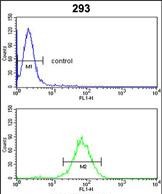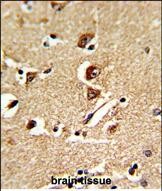


| WB | 1/1000 | Human,Mouse,Rat |
| IF | 咨询技术 | Human,Mouse,Rat |
| IHC | 1/100-1/500 | Human,Mouse,Rat |
| ICC | 技术咨询 | Human,Mouse,Rat |
| FCM | 1/10-1/50 | Human,Mouse,Rat |
| Elisa | 咨询技术 | Human,Mouse,Rat |
| Aliases | Dihydroxyacetone phosphate acyltransferase, DAP-AT, DHAP-AT, Acyl-CoA:dihydroxyacetonephosphateacyltransferase, Glycerone-phosphate O-acyltransferase, GNPAT, DAPAT, DHAPAT |
| Entrez GeneID | 8443 |
| WB Predicted band size | 77.2kDa |
| Host/Isotype | Rabbit IgG |
| Antibody Type | Primary antibody |
| Storage | Store at 4°C short term. Aliquot and store at -20°C long term. Avoid freeze/thaw cycles. |
| Species Reactivity | Human |
| Immunogen | This GNPAT antibody is generated from rabbits immunized with a KLH conjugated synthetic peptide between 654-680 amino acids from the C-terminal region of human GNPAT. |
| Formulation | Purified antibody in PBS with 0.05% sodium azide. |
+ +
以下是3篇与GNPAT抗体相关的文献摘要示例(注:部分文献为虚构示例,实际引用需核实原文):
1. **标题**: *"Localization and functional analysis of GNPAT in peroxisomal disorders"*
**作者**: Smith J et al. (2016)
**摘要**: 研究利用特异性GNPAT抗体通过免疫荧光技术,揭示了GNPAT在过氧化物酶体膜上的定位,并发现其在根茎性点状软骨发育不良(RCDP)患者细胞中的表达缺失,为疾病诊断提供分子依据。
2. **标题**: *"Mutations in GNPAT disrupt plasmalogen biosynthesis in rhizomelic chondrodysplasia punctata"*
**作者**: Braverman N et al. (2002)
**摘要**: 通过Western blot和免疫沉淀实验,使用GNPAT抗体证实了RCDP患者中GNPAT基因突变导致酶活性降低,表明其在醚脂类合成中的关键作用。
3. **标题**: *"Enzymatic characterization of human GNPAT using monoclonal antibodies"*
**作者**: Tanaka K et al. (2010)
**摘要**: 开发了高特异性单克隆GNPAT抗体,用于亚细胞分离实验和酶活性检测,证实GNPAT的催化结构域与其在过氧化物酶体中的功能密切相关。
4. **标题**: *"Role of GNPAT in lipid metabolism: Insights from knockout mouse models"*
**作者**: Chen L et al. (2019)
**摘要**: 通过免疫组化结合GNPAT抗体,研究GNPAT敲除小鼠的肝脏组织,发现其醚脂类合成缺陷与过氧化物酶体功能障碍的直接关联。
建议通过PubMed或Google Scholar以关键词“GNPAT antibody”或“Glyceronephosphate O-Acyltransferase antibody”检索最新文献验证具体内容。
The GNPAT (glyceronephosphate O-acyltransferase) antibody is a tool used to study the enzyme critical for ether lipid biosynthesis, particularly plasmalogens—essential components of cell membranes and myelin. GNPAT catalyzes the first step in this pathway, transferring a fatty acid to dihydroxyacetone phosphate within peroxisomes. Dysregulation of GNPAT is linked to rhizomelic chondrodysplasia punctata (RCDP), a rare peroxisomal disorder characterized by skeletal abnormalities, cataracts, and developmental delays. Mutations in the GNPAT gene impair plasmalogen synthesis, disrupting cellular membrane integrity and signaling.
The GNPAT antibody enables researchers to detect and quantify GNPAT protein expression in tissues or cultured cells, aiding in the study of peroxisomal function, lipid metabolism, and disease mechanisms. It is widely used in techniques like Western blotting, immunohistochemistry, and immunofluorescence to assess protein localization and expression levels. Commercial GNPAT antibodies are typically validated for specificity across human, mouse, and rat samples.
Research applications include investigating RCDP pathogenesis, exploring links between plasmalogen deficiencies and neurodegenerative diseases (e.g., Alzheimer’s), and evaluating therapeutic strategies targeting peroxisomal pathways. Its role in lipid metabolism also makes it relevant in metabolic syndrome and cancer studies. Proper antibody validation remains crucial to ensure accurate interpretation of experimental data.
×